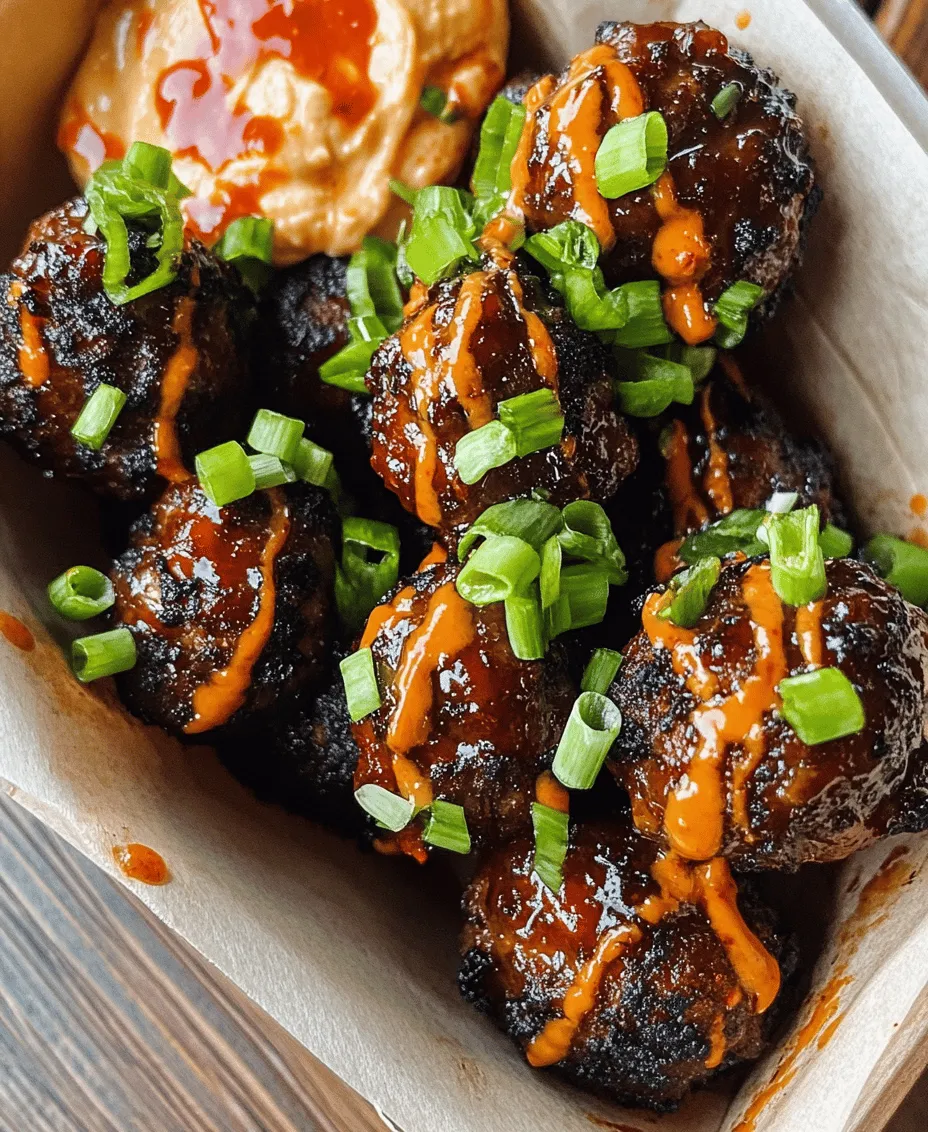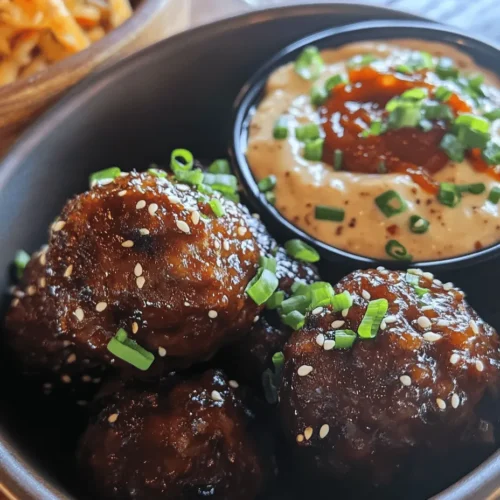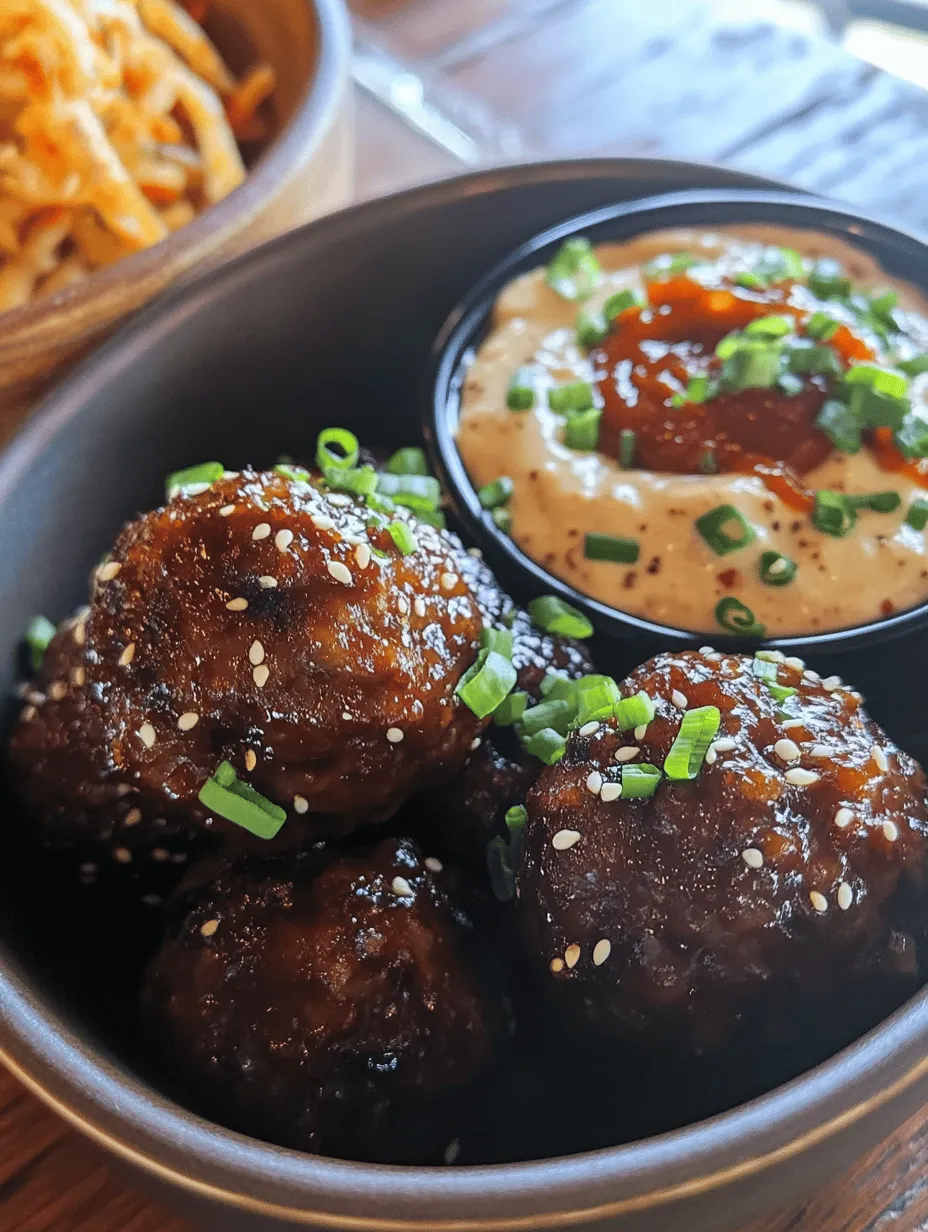Introduction
Korean BBQ Meatballs are a delightful fusion of flavors that encapsulate the savory essence of Korean cuisine while offering the comfort of a home-cooked dish. These meatballs are not just a meal; they are an experience, bringing the vibrant tastes of Korea into your kitchen. Perfect for family gatherings, parties, or a casual weeknight dinner, these meatballs are not only delicious but also versatile, pairing wonderfully with a spicy mayo dip that adds a kick to every bite.
The beauty of Korean BBQ Meatballs lies in their adaptability. They can be served as an appetizer, a main dish, or even as a component in a larger spread of Korean-inspired dishes. The combination of tender meat, aromatic herbs, and a hint of sweetness creates a delightful balance that is sure to impress your guests and family alike. In this article, we will provide a comprehensive guide to making these mouth-watering meatballs, exploring their ingredients, preparation methods, and serving suggestions, while also diving into the cultural significance of Korean BBQ.
Understanding the Ingredients
To truly appreciate the depth of flavor in Korean BBQ Meatballs, it’s essential to understand the key ingredients that contribute to their unique taste and texture. Each component plays a significant role in creating the final dish, ensuring that every bite is packed with flavor.
Ground Beef or Pork
The choice of meat is fundamental in any meatball recipe, and for Korean BBQ Meatballs, both ground beef and ground pork have their unique merits. Ground beef offers a robust flavor and a satisfying texture, while ground pork is often juicier and has a slightly sweeter taste. The meat serves as the base for the meatballs, providing a hearty foundation that absorbs the other ingredients’ flavors. When selecting your meat, consider buying a blend that contains some fat, as it will keep the meatballs moist during cooking.
Cooked White Rice
In traditional Korean cooking, rice is more than just a side dish; it’s an integral part of the meal. In this recipe, cooked white rice acts as a binding agent, helping to hold the meatballs together while also adding moisture. The starch in the rice helps create a tender texture, ensuring that the meatballs are not dense or dry. You can use leftover rice from previous meals, making this ingredient not only practical but also a great way to reduce food waste.
Green Onions and Garlic
No Korean dish is complete without the aromatic flavors of green onions (scallions) and garlic. These essential aromatics enhance the overall flavor profile of the meatballs, providing a fresh and savory element. Green onions contribute a mild onion flavor and a pop of color, while garlic adds depth and richness. Mincing these ingredients finely ensures that their flavors disperse evenly throughout the meat mixture.
Gochujang
At the heart of Korean flavor is gochujang, a fermented chili paste that is both savory and slightly sweet. This ingredient is a must-have in any Korean-inspired dish, and it infuses the meatballs with a distinctive umami flavor. Gochujang not only adds heat but also a unique depth that enhances the overall taste of the meatballs. If you’re new to this ingredient, you can find gochujang in most Asian grocery stores or online, and it’s well worth the purchase for its versatility in various recipes.
Sesame Oil and Brown Sugar
To round out the flavors of the meatballs, we incorporate sesame oil and brown sugar. Sesame oil brings a rich, nutty aroma that is characteristic of many Asian dishes. It adds complexity and a hint of warmth to the meatballs. On the other hand, brown sugar provides a touch of sweetness that balances out the heat from the gochujang, creating a harmonious flavor profile. This combination of savory, sweet, and spicy is what makes Korean BBQ so beloved.
Spicy Mayo Dip
To elevate the experience of enjoying Korean BBQ Meatballs, we cannot overlook the importance of a well-crafted spicy mayo dip. This modern twist complements the meatballs perfectly, adding creaminess and a kick of heat. The combination of mayonnaise, sriracha, and a touch of lime juice creates a dip that is both flavorful and addictive. It’s simple to make and can be adjusted to your preferred spice level, making it a versatile accompaniment to not just meatballs, but also other dishes like spring rolls or grilled vegetables.
Preparation Steps for Korean BBQ Meatballs
Creating the perfect Korean BBQ Meatballs requires attention to detail and a few key preparation steps. By following these guidelines, you’ll ensure that your meatballs turn out deliciously every time.
Preheating the Oven
Before you begin mixing your ingredients, it’s crucial to preheat your oven to 400°F (200°C). A hot oven is essential for even cooking and helps to develop a nice crust on the meatballs. This initial step not only saves time but also ensures that your meatballs cook through properly without drying out.
Mixing the Meatball Ingredients
Once your oven is preheated, it’s time to start mixing the meatball ingredients. In a large mixing bowl, combine your choice of ground beef or pork with cooked white rice, minced green onions, minced garlic, gochujang, sesame oil, and brown sugar. It’s best to use your hands to mix the ingredients thoroughly, but be careful not to overmix, as this can lead to tough meatballs. Aim for a consistency that is cohesive yet still tender. The incorporation of rice and aromatics should be even, allowing every meatball to be packed with flavor.
Shaping the Meatballs
After mixing your ingredients, the next step is to shape the meatballs. To ensure uniformity in size, you can use a tablespoon or a small ice cream scoop to portion the mixture. Roll each portion between your hands to form smooth, round meatballs. Keeping them consistent in size ensures that they cook evenly. Aim for about 1 to 1.5 inches in diameter, as this size will allow for optimal cooking time and a satisfying bite.
Baking Process
Once your meatballs are shaped, it’s time to bake them. Arrange the meatballs on a baking sheet lined with parchment paper or a silicone baking mat, allowing space between each one for even cooking. Place the sheet in your preheated oven and bake for about 20-25 minutes, or until the meatballs are cooked through and reach an internal temperature of 165°F (74°C). The baking method not only makes the meatballs healthier by reducing the amount of oil needed but also allows their flavors to meld beautifully as they cook.
Crafting the Spicy Mayo Dip
While your meatballs are baking, you can whip up the spicy mayo dip. In a small mixing bowl, combine mayonnaise, sriracha, and lime juice. Adjust the amount of sriracha based on your heat preference, and mix until the ingredients are well combined. Taste and adjust seasoning if necessary; you can add a pinch of salt or a bit more lime juice for acidity. This simple yet flavorful dip will elevate your meatballs and offer a delightful contrast to the savory flavors of the dish.
Stay tuned for the next part of the article, where we will delve into serving suggestions, tips for achieving the best results, and answer some common questions about this mouthwatering dish!

Ingredients Breakdown: The Role of Each Component in the Dip
Creating a spicy mayo dip that perfectly complements Korean BBQ meatballs requires a careful selection of ingredients, each contributing to the overall flavor profile and texture. Here’s a breakdown of the essential components used in the dip, and their roles:
– Mayonnaise: The base of the dip, mayonnaise provides a creamy texture that balances the heat from other ingredients. It acts as a neutral backdrop, allowing the flavors of the spices to shine through.
– Sriracha Sauce: This popular chili sauce brings the heat to the dip, offering a sweet and spicy kick. The unique flavor profile of Sriracha enhances the overall taste, making the dip an exciting accompaniment to the meatballs.
– Sesame Oil: A small amount of sesame oil adds depth and a nutty flavor to the dip. This ingredient is often used in Asian cooking and helps to bridge the flavors between the meatballs and the dip.
– Rice Vinegar: This ingredient provides acidity, balancing the richness of the mayonnaise and the heat of the Sriracha. Rice vinegar adds a slight tang and enhances the freshness of the dip.
– Garlic Powder: A pinch of garlic powder gives the dip an extra layer of flavor without overpowering the other ingredients. It complements the savory notes of the meatballs while adding a bit of warmth.
– Green Onions: Chopped green onions add a fresh, crisp element to the dip. Their mild flavor brightens the taste and adds a pop of color, making the dip more visually appealing.
Mixing Techniques: Whipping Up the Dip to Achieve a Smooth Texture
To create a smooth and creamy spicy mayo dip, follow these simple mixing techniques:
1. Combine Ingredients: In a medium mixing bowl, start by adding the mayonnaise as the base. Then, carefully measure and add Sriracha, sesame oil, rice vinegar, garlic powder, and a pinch of salt.
2. Whisk Thoroughly: Use a whisk or a fork to combine the ingredients thoroughly. Start mixing slowly to avoid splattering, gradually increasing the speed until the dip is smooth and well-blended. The goal is to ensure the Sriracha and sesame oil are evenly distributed throughout the mayonnaise.
3. Taste and Adjust: After mixing, take a small taste of the dip. This is your opportunity to adjust flavors according to your preferences. If you prefer more heat, add a little more Sriracha. For a tangier flavor, a few drops of rice vinegar can enhance the overall taste.
4. Chill Before Serving: For the best flavor, let the dip chill in the refrigerator for at least 30 minutes before serving. This resting period allows the flavors to meld and intensify, resulting in a more cohesive taste.
Adjusting Heat Levels: Personalizing the Dip to Cater to Different Palates
One of the great aspects of the spicy mayo dip is its adaptability. Here are some tips for adjusting the heat levels to cater to different palates:
– For Mild Heat: If you’re serving guests who prefer milder flavors, reduce the amount of Sriracha used. Start with a small amount (1 tablespoon) and gradually increase until the desired heat level is achieved. You can also mix in a bit of honey to balance the heat with sweetness.
– For Extra Spicy: For those who enjoy a pronounced kick, consider adding additional spicy ingredients. You might incorporate a few drops of chili oil or even finely minced fresh chilies. Just be sure to taste as you go to ensure the dip doesn’t become overwhelmingly spicy.
– Garnishing Options: Top the dip with thinly sliced jalapeños or a sprinkle of crushed red pepper flakes for an added visual cue and extra heat. This not only makes the dip more appealing but also lets guests know what to expect in terms of spice.
Serving Suggestions for Korean BBQ Meatballs
Korean BBQ meatballs are versatile and can be enjoyed in numerous creative ways. Here are some serving suggestions that elevate the dish:
Plating Ideas: Making the Dish Visually Appealing for Guests
Presentation is key when serving Korean BBQ meatballs. Here are some ideas to make the dish visually striking:
– Skewered Presentation: Serve the meatballs on skewers for a fun and easy way to eat. Alternate the meatballs with colorful vegetables like bell peppers and cherry tomatoes for added visual appeal.
– Garnish with Fresh Herbs: Sprinkle chopped cilantro or fresh green onions over the plated meatballs. This adds a burst of color and freshness that enhances the dish’s overall aesthetic.
– Serve on a Wooden Board: For a rustic touch, arrange the meatballs on a wooden serving board, accompanied by small bowls of the spicy mayo dip. This communal style encourages sharing and creates a casual dining experience.
Pairing with Sides: Suggestions for Sides That Complement the Meatballs
To create a well-rounded meal, consider these side dishes that pair beautifully with Korean BBQ meatballs:
– Steamed Rice: A classic accompaniment, steamed white or brown rice absorbs the flavors of the meatballs and dip, providing a neutral base.
– Kimchi: The tangy and spicy flavors of kimchi offer a perfect contrast to the savory meatballs. It adds a probiotic-rich element to the meal, enhancing its nutritional value.
– Stir-Fried Vegetables: A colorful mix of stir-fried vegetables, such as bok choy, bell peppers, and carrots, adds texture and nutrition to the meal. The vibrant colors make the plate more appealing and add freshness.
– Cucumber Salad: A light cucumber salad dressed with rice vinegar and sesame oil can provide a refreshing crunch that balances the richness of the meatballs.
Incorporating into Meals: How to Use the Meatballs in Different Culinary Contexts
Korean BBQ meatballs can be used in various culinary contexts beyond standalone appetizers. Here are a few ideas:
– In Sandwiches: Use the meatballs as a filling for a sandwich or a wrap. Add some fresh greens, sliced cucumbers, and a drizzle of the spicy mayo for a delicious lunch option.
– In Salads: Toss the meatballs into a salad with mixed greens, shredded cabbage, and carrots. Drizzle the spicy mayo as a dressing for a flavorful and satisfying meal.
– As Pizza Toppings: Get creative by using the meatballs as a topping for homemade or store-bought pizza. Add some mozzarella cheese and bake until bubbly for a unique fusion dish.
Cultural Significance of Korean BBQ
Understanding the cultural significance of Korean BBQ not only enriches your culinary experience but also provides context for the flavors you are enjoying.
Origins of Korean BBQ: A Brief Overview of Its Roots and Evolution
Korean BBQ has deep roots in Korean history, with origins tracing back to the Goguryeo dynasty (37 BC – 668 AD). The practice of grilling meat over an open flame became popular among the nobility, and as cooking techniques evolved, so did the accessibility of grilling. The communal dining experience, where friends and family gather around a grill to cook and eat together, has become a cherished tradition.
During the Korean War and subsequent globalization, Korean BBQ gained international popularity, leading to various interpretations worldwide. Today, it remains a staple in Korean culture, celebrated for its flavor and the social aspect of dining together.
The Role of Meatballs in Korean Cuisine: How This Dish Fits into the Larger Culinary Landscape
While meatballs are not a traditional part of Korean cuisine, they have found their place in modern interpretations of Korean dishes. Incorporating ground meat into various recipes reflects the adaptability of Korean cooking. Korean meatballs often feature flavors like garlic, ginger, and soy sauce, which align with traditional Korean seasoning.
These meatballs can be served in various ways, from appetizers to main courses, showcasing the versatility of Korean flavors through a contemporary lens.
Modern Interpretations: Fusion Cuisine and Its Impact on Traditional Recipes
As culinary borders blur, fusion cuisine has taken traditional dishes and reimagined them for modern palates. Korean BBQ meatballs exemplify this trend by combining classic Korean flavors with universally loved formats like meatballs. Chefs and home cooks alike experiment with different proteins, sauces, and spices, creating innovative dishes that celebrate the spirit of Korean BBQ while appealing to a global audience.
This fusion allows for creativity in the kitchen, encouraging experimentation while staying true to the essence of Korean culinary traditions.
Nutritional Aspects of Korean BBQ Meatballs
Korean BBQ meatballs are not only flavorful but also offer several nutritional benefits, making them a satisfying choice for a balanced meal.
Protein Source: The Benefits of Using Ground Beef or Pork
Ground beef or pork serves as an excellent source of protein, essential for building and repairing tissues in the body. Protein-rich foods help keep you feeling fuller for longer and can aid in muscle development. The inclusion of lean meat in the recipe ensures that you are consuming a good-quality protein source, especially when paired with other nutritious ingredients.
Nutritional Value of Rice and Vegetables: The Balance of Carbohydrates and Nutrients
When served with steamed rice and vegetables, Korean BBQ meatballs create a well-rounded meal. Rice provides carbohydrates that serve as a primary energy source, while vegetables contribute essential vitamins, minerals, and fiber. This balance is crucial for maintaining overall health and well-being. By incorporating a variety of colorful vegetables, you enhance the meal’s nutritional profile and add visual appeal.
Moderation and Flavor: Enjoying Flavorful Dishes Without Compromising Health
While Korean BBQ meatballs and their accompanying dip are rich in flavor, moderation is key. Enjoying these delicious dishes as part of a balanced diet allows you to savor the taste without compromising your health. Consider portion sizes and complement the meatballs with lighter sides, focusing on whole foods to create a nutritious meal.
Conclusion
Korean BBQ Meatballs with Spicy Mayo Dip are a celebration of flavors that reflect the richness of Korean culinary traditions while being accessible to home cooks. With their savory profile and the added zing of the spicy mayo dip, these meatballs are sure to be a hit at any dining occasion. Whether you are a seasoned cook or a kitchen novice, this recipe offers a simple yet rewarding experience, inviting everyone to savor the delightful blend of ingredients that make it truly special. Explore the cultural significance behind this dish, enjoy the nutritional benefits, and get creative with your serving ideas to truly appreciate the essence of Korean BBQ in your own home.



